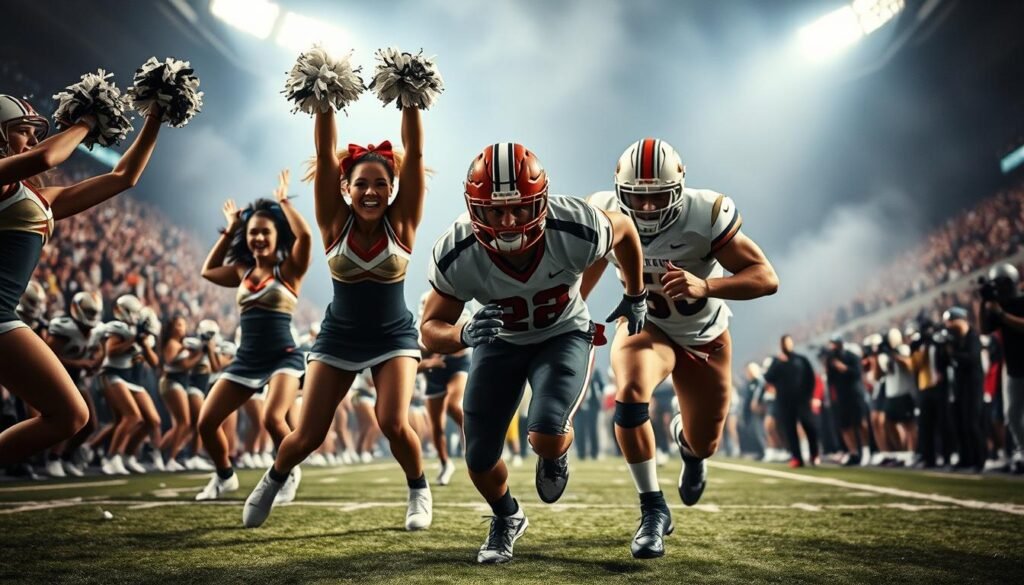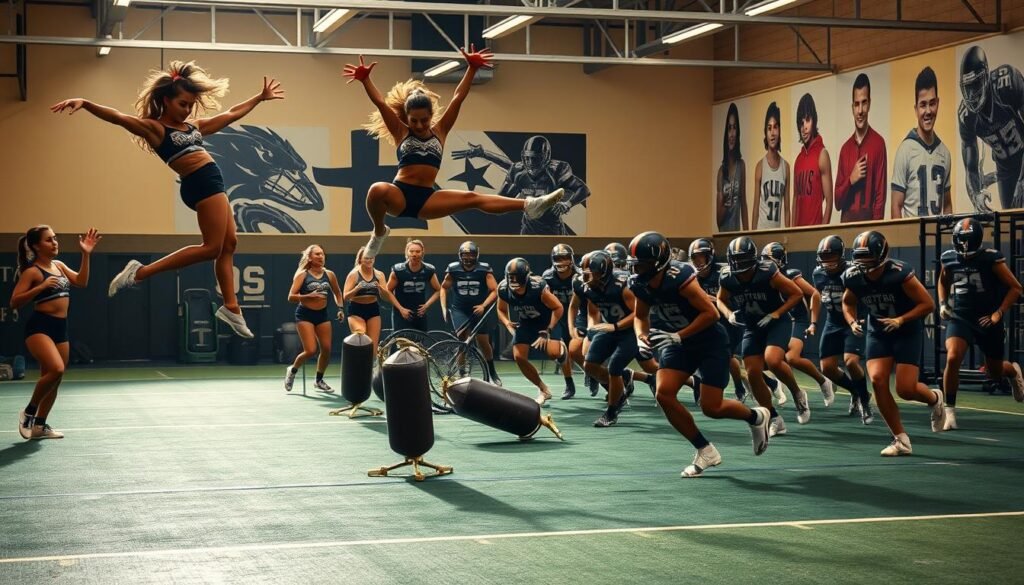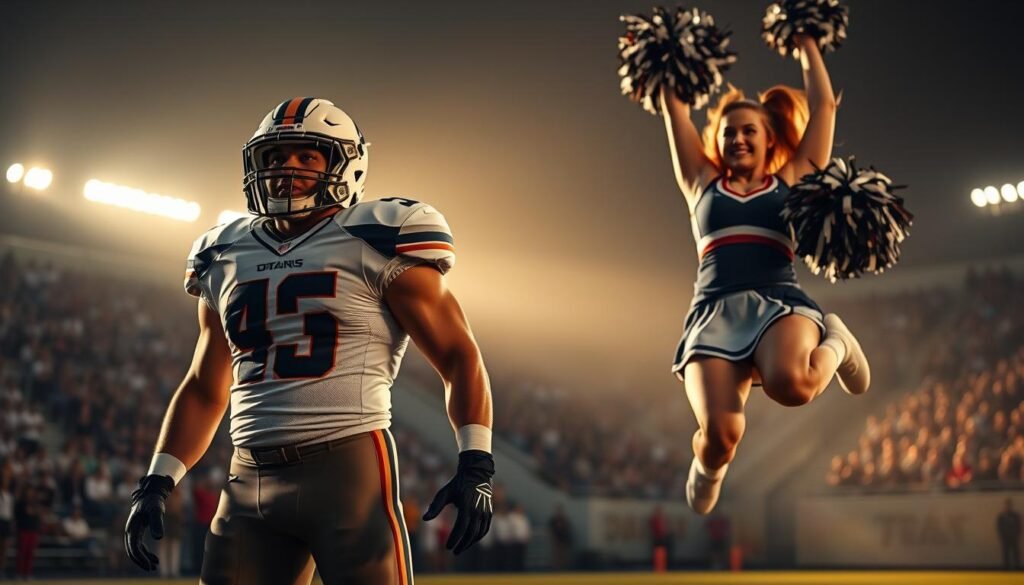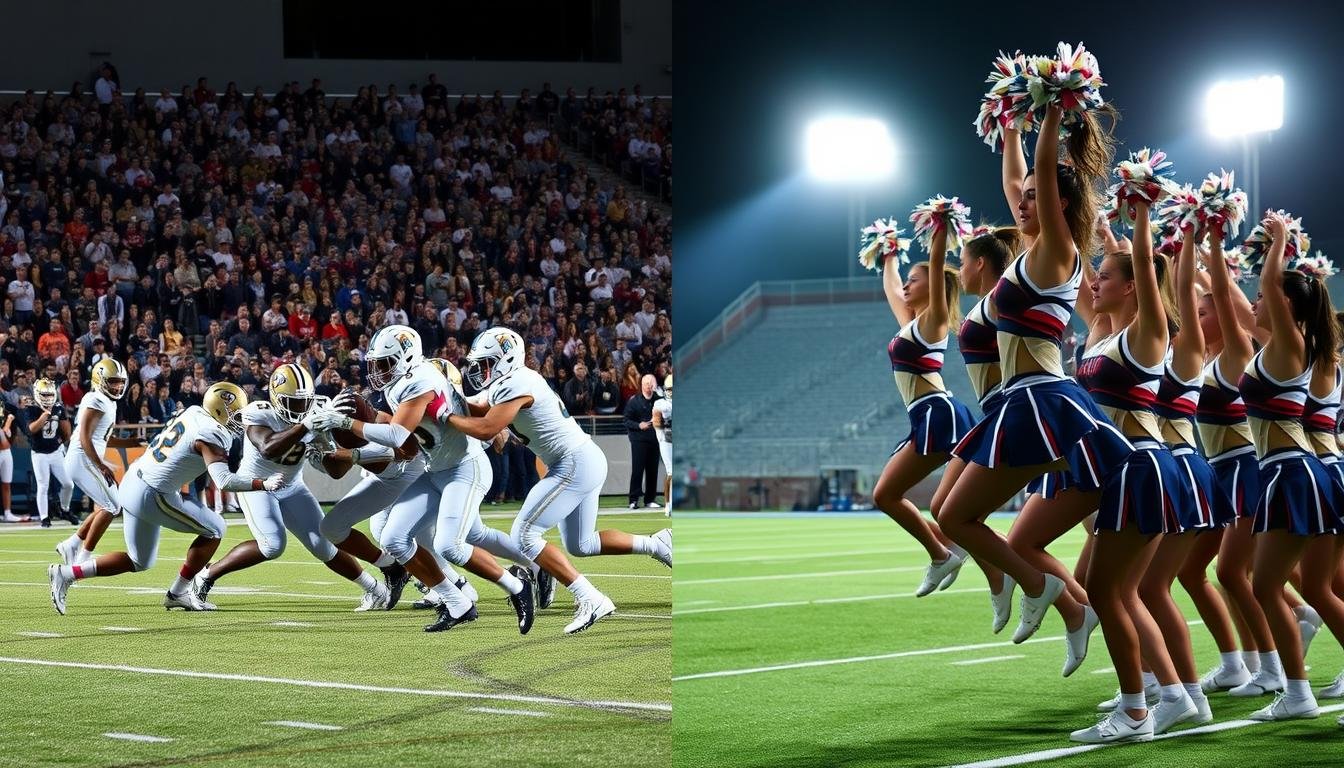Is Cheerleading More Harder Than Football? Have you ever thought, is cheerleading challenging than football? The debate on this topic has been going on for a while. Both sides have strong points to make. It’s interesting to think about which sport demands more skill and stamina.
Looking at the challenges of cheerleading and football, we see they have different demands. The question of which is harder is complex. It really depends on how you see it. Both sports need a lot of practice, dedication, and physical fitness.
Exploring the differences between cheerleading and football, we learn about their unique challenges. Cheerleading requires strength and agility for stunts and tumbling. Football is intense, needing strength, agility, and strategy. It’s not just about which is harder. It’s about the respect for athletes in both sports.
Contents
- 1 Breaking Down the Cheerleading vs Football Debate
- 2 Physical Demands: Is Cheerleading Harder Than Football?
- 3 The Technical Skills Required in Both Sports
- 4 Mental Toughness and Psychological Challenges
- 5 Injury Risks and Safety Considerations
- 6 Training Regimens and Time Commitments
- 7 Competition Levels and Performance Pressure
- 8 Expert Perspectives on Sport Difficulty
- 9 Statistical Analysis of Both Sports
- 10 Conclusion: Different Challenges, Equal Respect
- 11 FAQ
- 11.1 Is cheerleading harder than football?
- 11.2 What are the main challenges in cheerleading compared to football?
- 11.3 How do the technical skills required in cheerleading and football compare?
- 11.4 What are the mental toughness and psychological challenges in cheerleading versus football?
- 11.5 Which sport has a higher risk of injury?
- 11.6 How do the training regimens and time commitments compare between cheerleading and football?
- 11.7 What are the key differences in the competition levels and performance pressures of cheerleading and football?
- 11.8 What do experts say about the difficulty of cheerleading versus football?
- 11.9 How do the statistics compare between cheerleading and football in terms of difficulty?
Breaking Down the Cheerleading vs Football Debate
When we talk about cheerleading challenges vs football challenges, it’s key to know the history of both. Cheerleading and football have their own unique challenges. Let’s look into the history and growth of both sports.
Cheerleading has changed from a simple activity to a competitive sport. Athletes now do complex stunts and tumbling passes. Football, on the other hand, has become a strategic game needing strength, speed, and agility. The debate comes from the physical and mental demands of each sport.
Some important points to think about when comparing cheerleading and football challenges include:
- Physical demands: Both sports need a lot of physical fitness, but in different ways.
- Technical skills: Cheerleading has detailed stunts and tumbling, while football needs strategic plays and teamwork.
- Mental toughness: Athletes in both sports must be mentally strong to perform under pressure.
By looking at these points, you can understand the cheerleading vs football debate better. Both sports require dedication, hard work, and a love for competition.
Physical Demands: Is Cheerleading Harder Than Football?
When we compare cheerleading and football, we must look at their physical demands. Cheerleading needs strength, flexibility, and endurance for stunts and tumbling. Football players need strength, speed, and agility to do well.
Both sports are tough in their own ways. Cheerleading requires quick energy shifts for stunts and tumbling. Football players must keep their energy up for the whole game.
Some key physical demands of both sports include:
- Strength: needed for cheerleading stunts and football tackles
- Flexibility: important for cheerleading tumbling and football agility
- Endurance: key for cheerleading routines and football games
Whether cheerleading or football is harder depends on who you ask. But, both sports need a lot of athleticism and fitness.
The Technical Skills Required in Both Sports
Looking at the technical skills needed for cheerleading and football shows their unique demands. Cheerleading is often seen as more technical because of the strength, flexibility, and coordination needed for stunts and tumbling. This is different from football, which focuses on speed, agility, and strategy.
Football players need to master skills like throwing, catching, and tackling. Both sports require a lot of physical fitness and mental toughness. This makes the intensity of cheerleading and football similar.
- Stunting and tumbling
- Jumping and flexibility
- Strength and conditioning
In football, technical skills such as:
- Throwing and catching
- Blocking and tackling
- Speed and agility training
are essential for success.
Cheerleading Technical Requirements
Cheerleading requires a solid base in gymnastics, dance, and stunts. Athletes need to master handstands, cartwheels, and back handsprings. They also have to work as a team to do complex stunts and routines.
Football Technical Requirements
Football focuses on skills like throwing, catching, and tackling. Players must also learn to work together as a team. They use strategy and communication to beat their opponents.
Skill Development Timelines
The time it takes to develop skills in cheerleading and football varies. Cheerleading athletes start training early, learning stunts and tumbling over years. Football players start training later, focusing on throwing and catching in their teens.
Mental Toughness and Psychological Challenges
Exploring competitive cheer vs football toughness reveals the mental side of sports. Studies on athletes in both fields offer insights into mental toughness and challenges. Competitive cheer and football require different mental strengths and drives.
Competitive cheer and football each pose unique mental hurdles. Cheerleading needs focus and concentration for complex routines. Football, on the other hand, requires a strong competitive spirit and aggression to beat opponents. Athletes in both sports use different mental strategies, showing the unique nature of each sport.
Several factors affect mental toughness in competitive cheer vs football toughness:
- Pressure to perform
- Fear of injury
- Team dynamics
- Personal motivation

Understanding these factors and the challenges they bring helps appreciate the mental strength needed in both sports. As you dive into competitive cheer vs football toughness, remember mental preparation is as important as physical training for success.
See Also: Is Air Force Basic Training Harder Than Army?
Injury Risks and Safety Considerations
When comparing cheerleading and football, it’s key to look at injury risks and safety. Cheerleading has complex stunts and tumbling passes. These can cause injuries if not done right.
Studies show common cheerleading injuries are concussions, ankle sprains, and wrist fractures. Football injuries include knee sprains, shoulder dislocations, and head trauma. Safety measures like proper warm-ups, equipment checks, and emergency plans are vital in both sports.
- Proper training and certification for coaches and athletes
- Regular equipment inspections and maintenance
- Emergency response plans and first aid kits on site
- Encouraging open communication about injuries and concerns
Knowing the injury risks and safety in cheerleading and football shows the need for proper training and equipment. This ensures a safe place for athletes to compete and succeed.
Training Regimens and Time Commitments
Looking at the comparison cheer and football difficulty, we see both sports need a lot of time and effort. Athletes in both sports usually spend 10-15 hours a week practicing, conditioning, and training. Coaches and athletes agree that a typical week is packed with hours of hard work.
The physical and mental challenges of cheer and football difficulty are significant. Athletes must commit to intense training to get ready for competitions and games. This includes strength exercises, technique practice, and strategy sessions. The time needed for each sport can differ, but both require a lot of dedication.
Here’s a breakdown of the typical time commitment for each sport:
- Cheerleading: 10-15 hours per week, including practice, conditioning, and training sessions
- Football: 15-20 hours per week, including practice, conditioning, and strategy sessions

The comparison cheer and football difficulty shows the unique challenges of each sport. Both sports require a big time investment, but the training specifics differ. Understanding these differences helps us see the hard work athletes put into their training.
Competition Levels and Performance Pressure
Exploring cheerleading and football reveals the importance of competition structures and athlete pressures. The cheerleading vs football difficulty debate centers on physical and mental demands. Cheerleading tests teams’ skills, strength, and unity through competitions. Football games, on the other hand, require strategic planning, endurance, and mental strength.
When comparing cheerleading challenges vs football challenges, each sport’s unique aspects must be considered. Cheerleading competitions demand precision and teamwork in routines, stunts, and tumbling passes. Football games, won or lost by individual skills, teamwork, and strategy, also face intense pressure. Athletes in both sports deal with performance anxiety factors like fear of injury, failure, and disappointing teammates.
- High expectations from coaches, teammates, and fans
- Fear of injury or illness
- Pressure to win or perform well
- Lack of experience or confidence
Understanding the competition levels and pressures in cheerleading and football highlights each sport’s unique challenges. Whether cheering or playing football, success comes from developing physical, mental, and emotional skills. These skills help athletes overcome challenges and perform at their best.
Expert Perspectives on Sport Difficulty
When we think about which is harder, cheerleading or football, we need to listen to the experts. Athletic trainers and sports medicine researchers share their insights on the physical and mental sides of each sport. It turns out, both sports have their own unique challenges and skills needed.
Experts say the difficulty in cheerleading and football comes from their different needs. Cheerleading asks for strength, flexibility, and endurance. On the other hand, football needs speed, agility, and strategy. Let’s dive into what athletic trainers and sports medicine research say about these differences.
Athletic Trainers’ Views
- Cheerleading coaches stress the need for right technique and safety to avoid injuries.
- Football trainers work on building strength, endurance, and agility to boost player skills.
Sports Medicine Research
Research shows both cheerleading and football have high injury risks. But, the injuries and how often they happen are different. Looking at the data and expert opinions helps us understand which sport is tougher.

In the end, whether cheerleading or football is harder depends on many things. It’s about the athlete’s experience and the sport’s demands. Remember, both sports need dedication, hard work, and a love for competition.
Statistical Analysis of Both Sports
Looking at cheerleading difficulty compared to football, we need to see the stats. Cheerleading has a higher injury rate than football. Most injuries in cheerleading happen during stunts and tumbling. Football injuries usually come from tackles and collisions.
Examining the stats further, we find that cheerleading difficulty compared to football isn’t just about injury numbers. Cheerleading injuries often lead to long-term problems like concussions and muscle issues. Football injuries, while severe, tend to be more immediate, like broken bones and sprains.
Here are some key statistics to consider:
- Cheerleading injuries account for approximately 20% of all high school sports injuries.
- Football injuries account for around 15% of all high school sports injuries.
- The most common cheerleading injuries are to the ankle, knee, and head.
- The most common football injuries are to the knee, shoulder, and head.
In conclusion, the stats show the unique challenges and risks of each sport. By looking at the data, we can improve safety and training in both cheerleading and football.
Conclusion: Different Challenges, Equal Respect
Looking at cheerleading and football, we see each sport has its own hurdles. Cheerleading might not be as physically demanding as football. Yet, it needs top-notch skills, endless dedication, and a drive for perfection. On the other hand, football requires a mix of athleticism, strategy, and the ability to handle tough physical play.
The question of whether cheerleading is harder than football is tricky. Both sports have their own tough demands. What’s clear is that athletes in both fields deserve the same respect and praise for their hard work and dedication. Their passion, strength, and commitment to being the best are truly inspiring, no matter the challenges they face.
FAQ
Is cheerleading harder than football?
What are the main challenges in cheerleading compared to football?
How do the technical skills required in cheerleading and football compare?
What are the mental toughness and psychological challenges in cheerleading versus football?
Which sport has a higher risk of injury?
How do the training regimens and time commitments compare between cheerleading and football?
What are the key differences in the competition levels and performance pressures of cheerleading and football?
What do experts say about the difficulty of cheerleading versus football?
How do the statistics compare between cheerleading and football in terms of difficulty?

Demetrius Harmon is a passionate blogger working in the shoe industry in California. With a deep knowledge of footwear trends and manufacturing processes, he shares insightful content that helps readers navigate the world of shoes.

